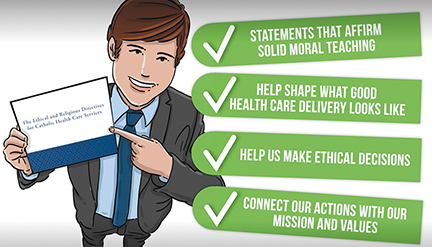CHA has released a new guide to help people understand, interpret and apply the Ethical and Religious Directives for Catholic Health Care Services.
The association also has produced a video that Catholic health care facilities can use to introduce new staff members and others to the directives and their use.
 Kane
KanePublished by the United States Conference of Catholic Bishops, the Ethical and Religious Directives document the ethical standards of behavior for providing health care services — standards derived from the Catholic Church's teaching about the
dignity of each person. The directives also provide authoritative guidance on certain moral issues that can arise in health care delivery. The purpose of the guide, called "The Ethical and Religious Directives: Annotations by the Catholic Health Association
of the United States," is to put those directives in context.
Brian M. Kane, CHA senior director of ethics, developed the annotations with CHA colleagues and with input from several dozen ethics experts from the Catholic health ministry as well as from the USCCB. He explains that over the several decades that the
Ethical and Religious Directives have been in use, there has been much discussion in the ministry about how to interpret them, and CHA and others have produced many resources to explain how to apply them.
 CHA produced a video that can be used to educate people about the Ethical and Religious Directives for Catholic Health Care Services. Ministry facilities can use the video for employee orientation.
CHA produced a video that can be used to educate people about the Ethical and Religious Directives for Catholic Health Care Services. Ministry facilities can use the video for employee orientation.Kane says the annotation summarizes contextual points and provides links to related articles and other resources.
The 37-page annotation is available in print and electronically. The annotation can be accessed at chausa.org/erds. There is a fee, with a discount for CHA members.
Kane notes that the annotation will be a "living document." CHA plans to produce new editions as the directives and the ministry's understanding of them evolve. The USCCB is in the process of amending the directives. Since their first publication in the
Linacre Quarterly journal in 1948, the directives have been revised six times, with the latest version published in 2018.
CHA also has produced a video on the Ethical and Religious Directives. The video makes the directives understandable to a broad audience, Kane says. Ministry systems and facilities can use the video to orient new colleagues to what the directives
are. There is a shorter version for general orientation and a longer version for orientation of colleagues who will work regularly with the directives, such as ethicists. CHA produced the video in response to association members' requests for such
a resource.
Sr. Mary Haddad, RSM, CHA president and CEO, explains in an introductory note to the annotation why it is so important to CHA to provide resources on the directives. She writes that the association offers resources "so that those who serve our patients,
and their loved ones can understand the medical and ethical conversations about particular issues."